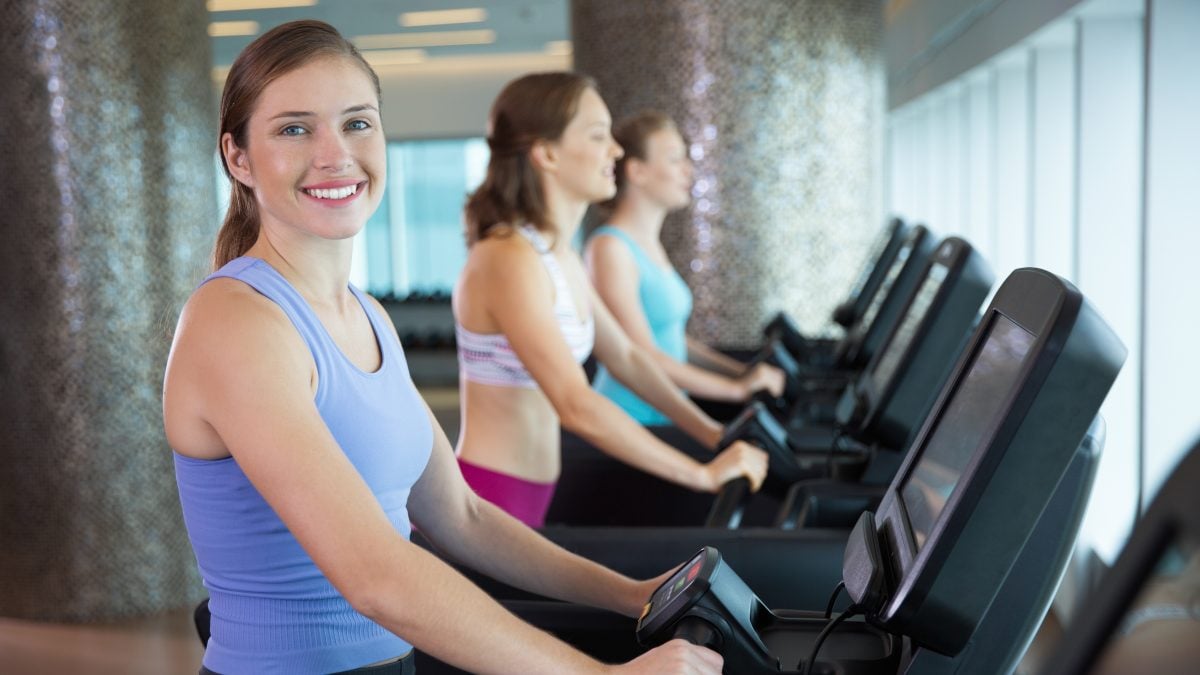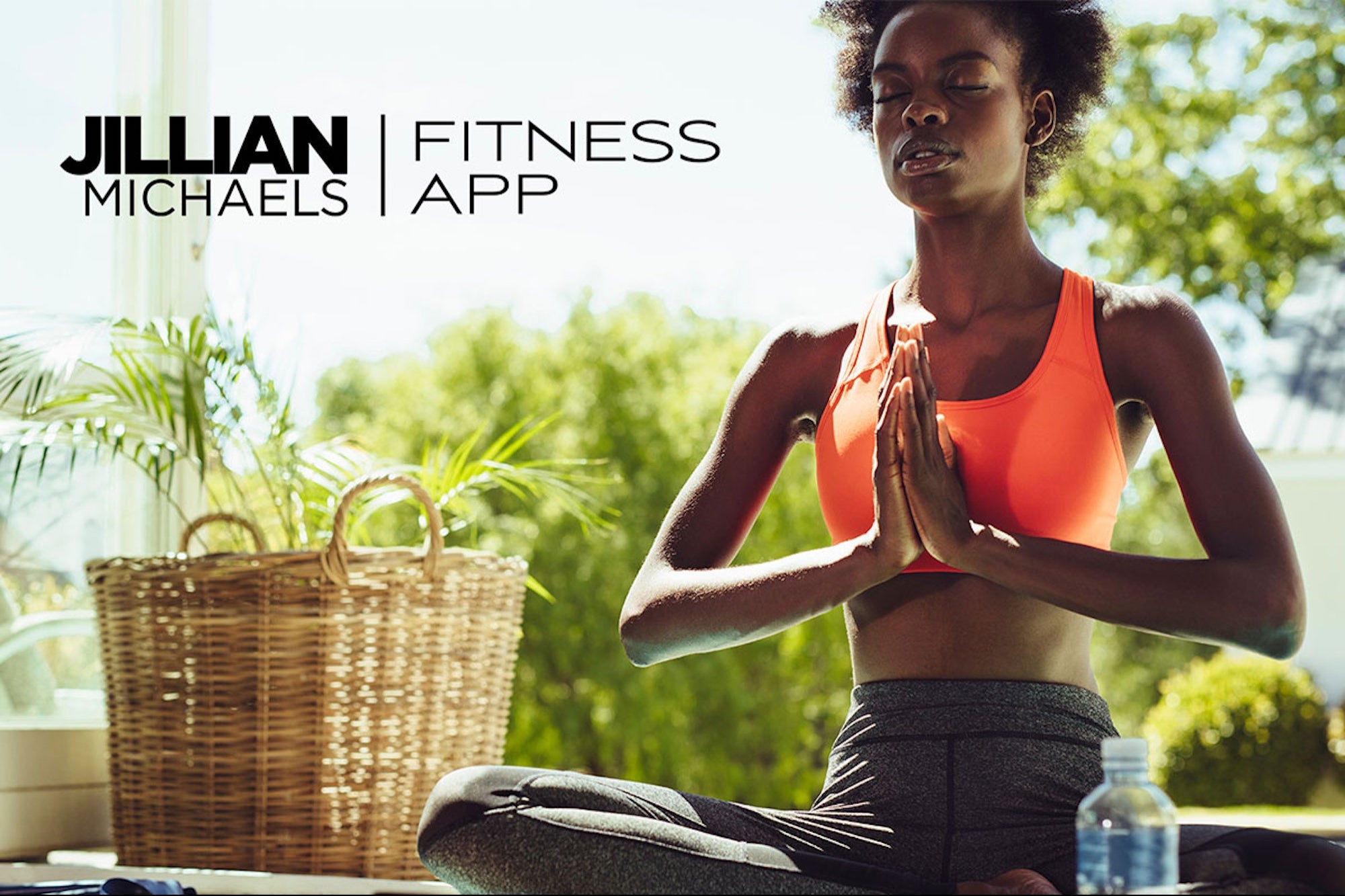Fitness
Top fitness apps to help you stay in shape

In this article, DANIEL ADAJI explores the different smart fitness technologies that are helping to transform the fitness landscape
The world of fitness is rapidly evolving, fuelled by advancements in technology that are reshaping how we exercise, monitor our health, and achieve our fitness goals.
Smart fitness technology, a blend of wearable devices, apps, and data-driven insights, has revolutionised the way people approach fitness by offering personalised, efficient, and connected workout experiences.
From tracking activity levels to optimising recovery, these innovations are becoming integral to our daily lives, improving overall well-being while also fostering a more dynamic, adaptable, and intelligent approach to staying healthy.
Rise of smart fitness technology
Smart fitness technology has its roots in the increasing use of sensors, algorithms, and data analytics in wearable devices, like fitness trackers and smartwatches.
Early versions of fitness technology, such as pedometers and heart rate monitors, laid the groundwork for today’s more advanced systems.
However, the explosion of interest in health tracking began with the rise of smartphones, which allowed more people to interact with health-related apps and devices.
As technology advanced, the fitness industry followed suit, adopting innovations that could not only monitor performance but also suggest improvements and optimize individual fitness plans.
The integration of artificial intelligence and machine learning has pushed this evolution even further.
AI-powered fitness platforms and wearable devices are now capable of delivering insights in real-time, adjusting workouts based on user feedback, and predicting future health trends based on patterns in a person’s data.
Key components of smart fitness technology
Smart fitness technology encompasses several components that work together to create a comprehensive health and fitness ecosystem. Some of the key elements include:
Wearable devices
Wearable devices, such as smartwatches and fitness trackers, have become indispensable tools for monitoring physical activity, heart rate, sleep patterns, and even blood oxygen levels.
These innovative gadgets utilise advanced sensors to gather real-time data, providing users with detailed insights into their health and well-being. With features like GPS tracking, calorie burn monitoring, and personalized recommendations, wearables empower individuals to optimize their fitness regimens and make informed lifestyle choices.
Additionally, wearables offer alerts for abnormal heart rhythms, stress levels, and other vital signs, enabling proactive health management.
Their convenience and accuracy have made wearables a staple in modern health tracking.
Fitness apps
Many fitness apps seamlessly integrate with wearable devices or function independently, providing a comprehensive fitness experience.
They offer a diverse range of workouts, tracking capabilities, and progress reports, empowering users to monitor their journey. Leveraging AI technology, these apps suggest personalised workouts based on individual goals, fitness levels, and preferences.
Additionally, they utilise motivational tools, such as rewards, challenges, and social sharing, to keep users engaged and driven. With features like virtual coaching, nutrition planning, and mindfulness exercises, fitness apps provide a holistic approach to wellness, helping users achieve their goals and maintain a healthy lifestyle.
Smart home gym equipment
High-tech home gym equipment, such as connected treadmills, stationary bikes, and smart weights, offer live workout classes and on-demand programs. These devices track a user’s performance and adjust settings automatically to ensure that workouts are challenging but safe.
Health Analytics
Behind many smart fitness devices is a powerful system of data analytics that helps users interpret the data collected during workouts.
This allows for personalised recommendations, such as adjusting intensity levels, recommending rest days, or even offering nutritional advice based on activity levels.
Virtual coaching and AI trainers
Virtual coaches are becoming more common in the fitness world. These AI-driven trainers offer real-time feedback during workouts, correct form, and push users to improve their performance.
This technology is especially helpful for people working out at home without a personal trainer or fitness instructor.
Recovery tools
Smart fitness technology has extended beyond workouts to include recovery. Tools like massage guns, compression boots, and smart foam rollers are equipped with sensors and analytics that help users recover faster and reduce muscle soreness.
Smart fitness devices and apps
Smart fitness technology is now a multi-billion-dollar industry with many players competing for consumer attention. Some of the most popular and widely used devices and apps in the market include:
Apple Watch
The Apple Watch is one of the most recognised wearable fitness devices. It tracks various health metrics, including heart rate, sleep patterns, and activity levels. The integration with Apple’s ecosystem also allows users to sync their health data with their iPhones and other devices.
Fitbit
Fitbit remains a leader in wearable fitness technology. Its products offer a range of health-tracking features, from step counting to heart rate monitoring and sleep tracking. Fitbit also integrates with its app, providing insights and personalized recommendations based on the user’s data.
Peloton
Peloton is well-known for its connected stationary bikes and treadmills, which allow users to participate in live and on-demand fitness classes from home. Peloton’s devices also track performance metrics like speed, distance, and resistance, helping users track their progress over time.
WHOOP
WHOOP is a high-end fitness tracker designed for athletes and serious fitness enthusiasts. It focuses on monitoring recovery, strain, and sleep, offering insights into how to optimize performance.
The device doesn’t have a screen, but the data is accessible through the WHOOP app, which provides detailed analytics on recovery and performance.
MyFitnessPal
A popular app for tracking diet and exercise, MyFitnessPal allows users to log meals, track calories, and monitor macronutrient intake. It’s particularly helpful for those trying to lose weight or maintain a balanced diet in conjunction with their fitness goals.
Oura ring
The Oura Ring is a smart wearable that tracks sleep and activity by analysing key health indicators like heart rate variability, body temperature, and movement. The device provides insights into the user’s readiness to perform, helping them make informed decisions about rest and recovery.
Mirror
The Mirror is an innovative fitness device that offers a full workout experience in the form of a sleek, interactive display. It streams live and on-demand fitness classes and provides real-time feedback on form and technique. The Mirror is a smart solution for those who want a personalized fitness experience at home without bulky equipment.
How smart fitness technology enhances workouts
Smart fitness technology provides users with a deeper understanding of their health and fitness, allowing them to improve in ways that would be difficult to achieve otherwise.
Here are some ways it enhances workouts:
Personalisations
One of the major benefits of smart fitness technology is its ability to deliver personalised workout experiences. With AI-driven insights, wearables and apps can analyse a user’s fitness level, preferences, and goals to create tailored workouts. This increases the likelihood of long-term success by ensuring workouts are suited to individual needs.
Real-time feedback
Devices like smartwatches and fitness trackers provide real-time feedback on performance, allowing users to adjust their workouts on the fly. Whether it’s increasing the intensity, changing the duration, or adjusting the form, users have access to data that keeps them on track.
Tracking and progress monitoring
Tracking progress is one of the key motivators for fitness enthusiasts. Smart fitness devices record every metric, from the number of steps taken to calories burned, which helps users monitor their progress and stay motivated. Some apps even offer social sharing features, creating an extra layer of accountability.
Injury prevention
Smart fitness technology can help prevent injuries by monitoring body mechanics and identifying potential issues before they become serious problems. AI-driven virtual coaches can suggest adjustments to form during workouts, while wearables can alert users if they are pushing too hard.
Enhanced recovery
Recovery is a critical part of any fitness plan, and smart fitness technology helps optimize this aspect. Recovery-focused devices and apps analyze sleep patterns, heart rate, and stress levels, offering recommendations to improve recovery times and reduce fatigue.
Motivation and gamification
Many fitness apps use gamification to keep users engaged. They offer rewards for meeting goals, create challenges, and even allow users to compete with friends or other app users. This social and competitive element can be a powerful motivator for maintaining consistent workouts.
The role of Artificial Intelligence and data in fitness
At the heart of smart fitness technology is data, and AI plays a significant role in interpreting that data to make workouts more effective. Machine learning algorithms can analyse vast amounts of health data from wearable devices and fitness apps, creating actionable insights for users.
For example, AI can predict how well a person will perform in their next workout based on their recovery data, helping them avoid overtraining.
AI also plays a role in virtual coaching, with some systems capable of adapting workouts in real-time based on the user’s performance.
These virtual coaches can offer personalised feedback, track forms, and suggest changes in exercises based on user-specific data. This kind of real-time adjustment can replicate the benefits of having a personal trainer without the high costs associated with in-person coaching.
Future of smart fitness technology
Looking ahead, the future of smart fitness technology is bright. We are likely to see continued innovation in the areas of AI, virtual reality, and augmented reality, which will further personalize fitness experiences and make them more immersive.
For instance, VR workouts could transport users to virtual environments where they can engage in fitness activities that feel more like games than workouts, making the process more enjoyable and engaging.
Another future trend is the development of more advanced health metrics and sensors that go beyond basic heart rate monitoring. As research in this area progresses, wearable devices may soon be able to monitor a wider range of health indicators, including hormone levels, glucose levels, and mental health metrics.
This would allow users to get an even deeper understanding of their health and adjust their fitness routines accordingly.
Additionally, smart fitness technology may continue to integrate with other areas of personal health, such as nutrition, sleep, and mental wellness, creating a more holistic approach to well-being.
For example, AI-driven systems could offer not just workout advice but also dietary and mental health recommendations based on a user’s physical activity and biometric data.
The rise of smart fitness technology marks a turning point in how we approach fitness and health. With real-time data, AI-driven insights, and personalised experiences, these innovations are empowering individuals to take control of their health in ways that were unimaginable just a few years ago.

Fitness
5+ ways to achieve your health and fitness goals and stay active in Auckland
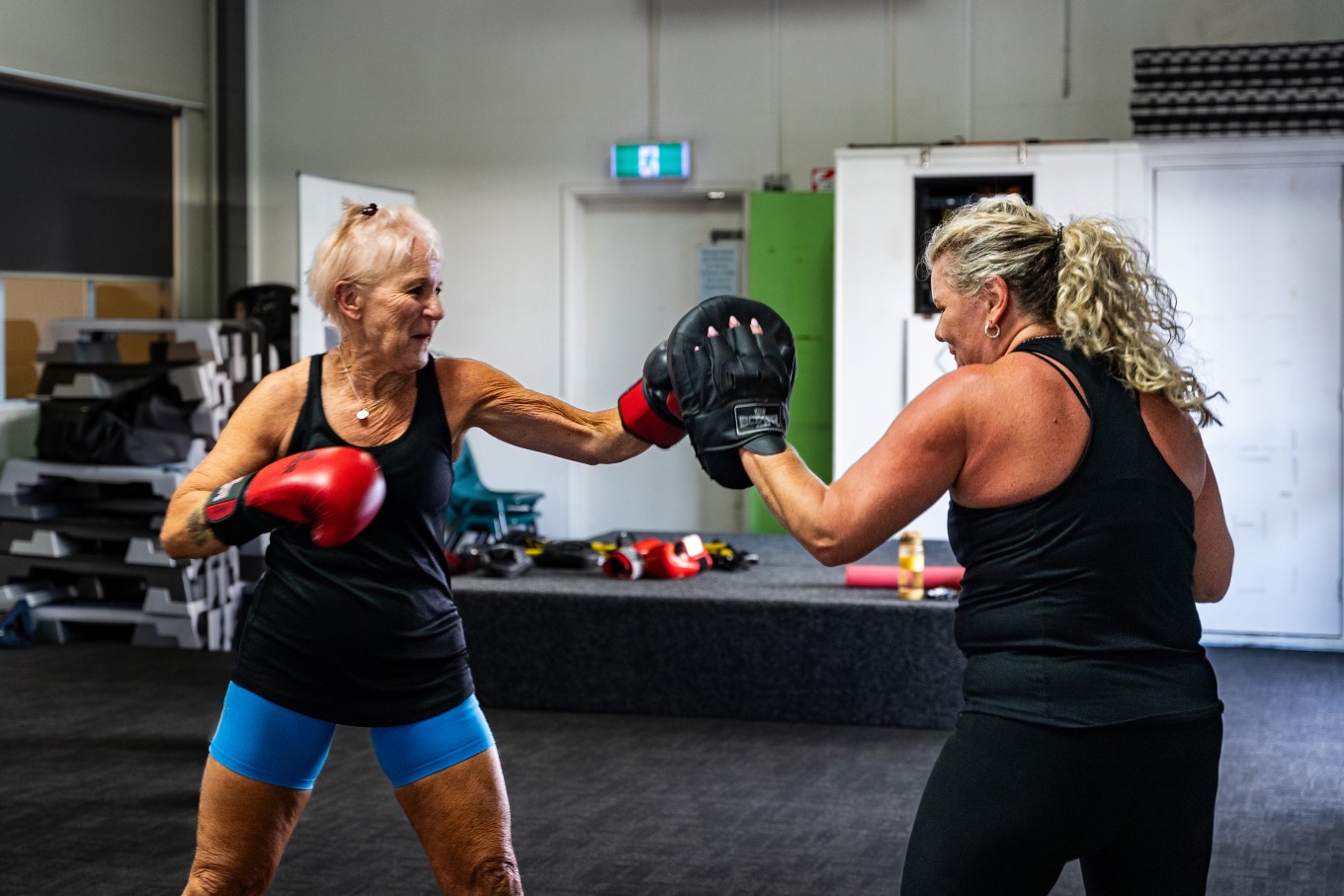
From the court to the coast, Tāmaki Makaurau is teeming with ways to stay active and thrive. If your New Year’s resolution is to make 2025 the ‘Year of You’ by focusing on health and wellbeing – or if you simply want to change up your current fitness routine – these Auckland activities will help you raise your heart rate while also making your heart sing.
If you plan to pair your exercise with a dose of vitamin D, there are plenty of parks and maunga that are the perfect location for you to step into action. Many parks around Auckland also have outdoor exercise equipment available, ranging from calisthenics equipment for training using your body weight, to outdoor machines such as a leg press and an arm cycle. If you’d prefer to have options for rainy days, then consider joining a gym at your local Auckland Council Pool and Leisure Centre.
At Marlborough Park in Glenfield, you can try out the exercise equipment such as the leg press while the rest of the family plays on the basketball court or playground.
Keen to make some net gains in your exercise routines? Consider smashing your fitness goals on the court. Tennis is fantastic cardiovascular exercise and it’s also good for strength, agility and mental stamina – especially when you’re challenging a friend to a match. There are more than 60 tennis courts around the region ready to serve. If you need racquets, why not visit your local Community Recycling Centre to find an ace second-hand option.
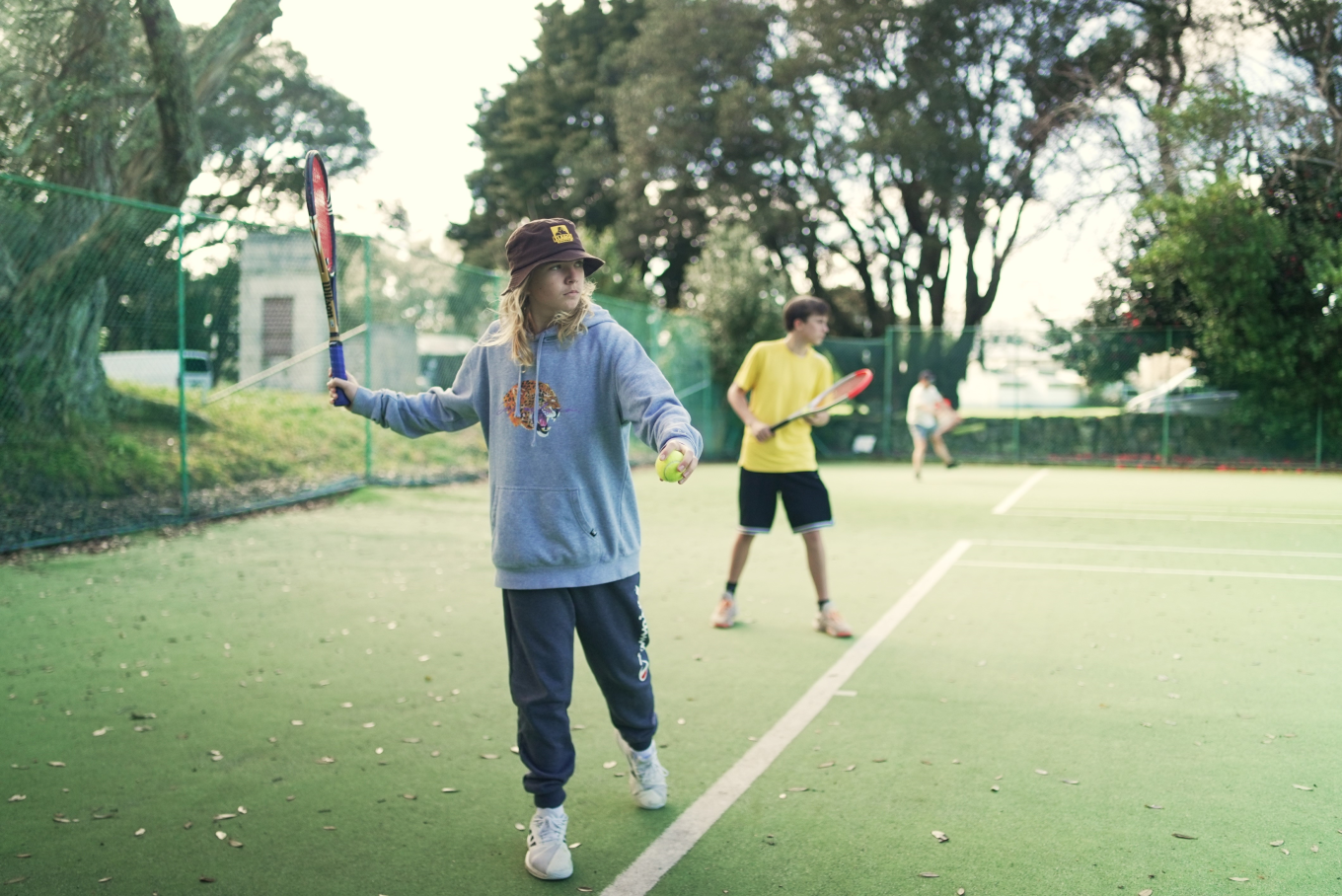
There are many tennis courts around Auckland great for a smashing good game, including at Mt Eden’s Nicholson Park.
Want to try something new? Try Pickleball. This fast-growing sport can be played at several Auckland Council Pool and Leisure Centres, and is a hybrid of tennis, table tennis and badminton. Played using a paddle and a wiffle ball, this fun sport is good for all ages, but it is especially suitable for seniors as the serve is underarm (easier on shoulders) and the court is slightly smaller.
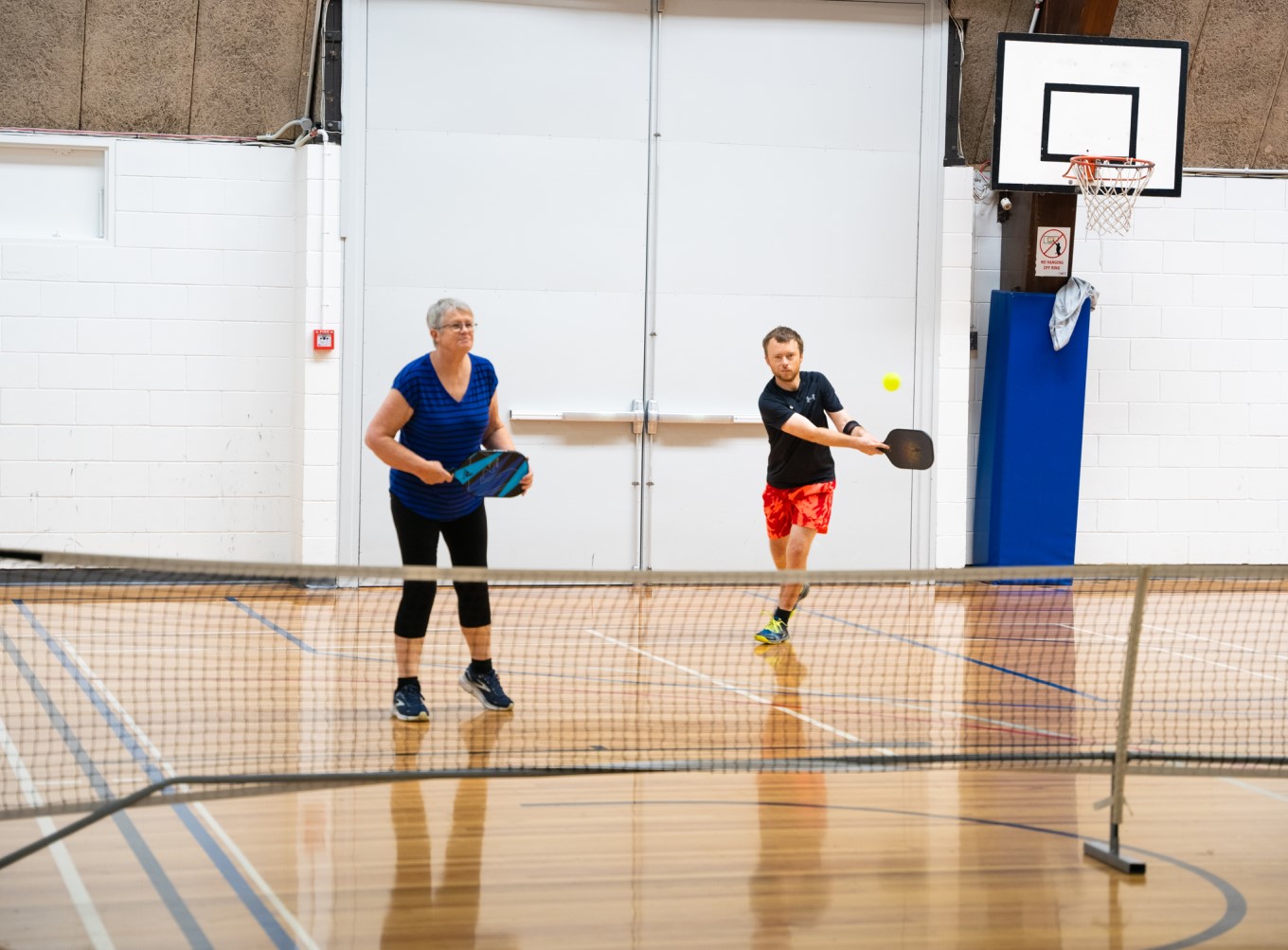
Pickleball is one of the fastest growing sports and is good for all ages.
Whether you’re hooked on BoxFit, kicking into gear at Body Combat or getting your fitness en pointe in a Barre class, there are a multitude of group fitness classes held at Auckland Council Pool and Leisure Centres across Auckland. Working out in a group is a great way to stay motivated, form an exercise routine and have fun, and there are classes dedicated to all fitness levels and age groups.
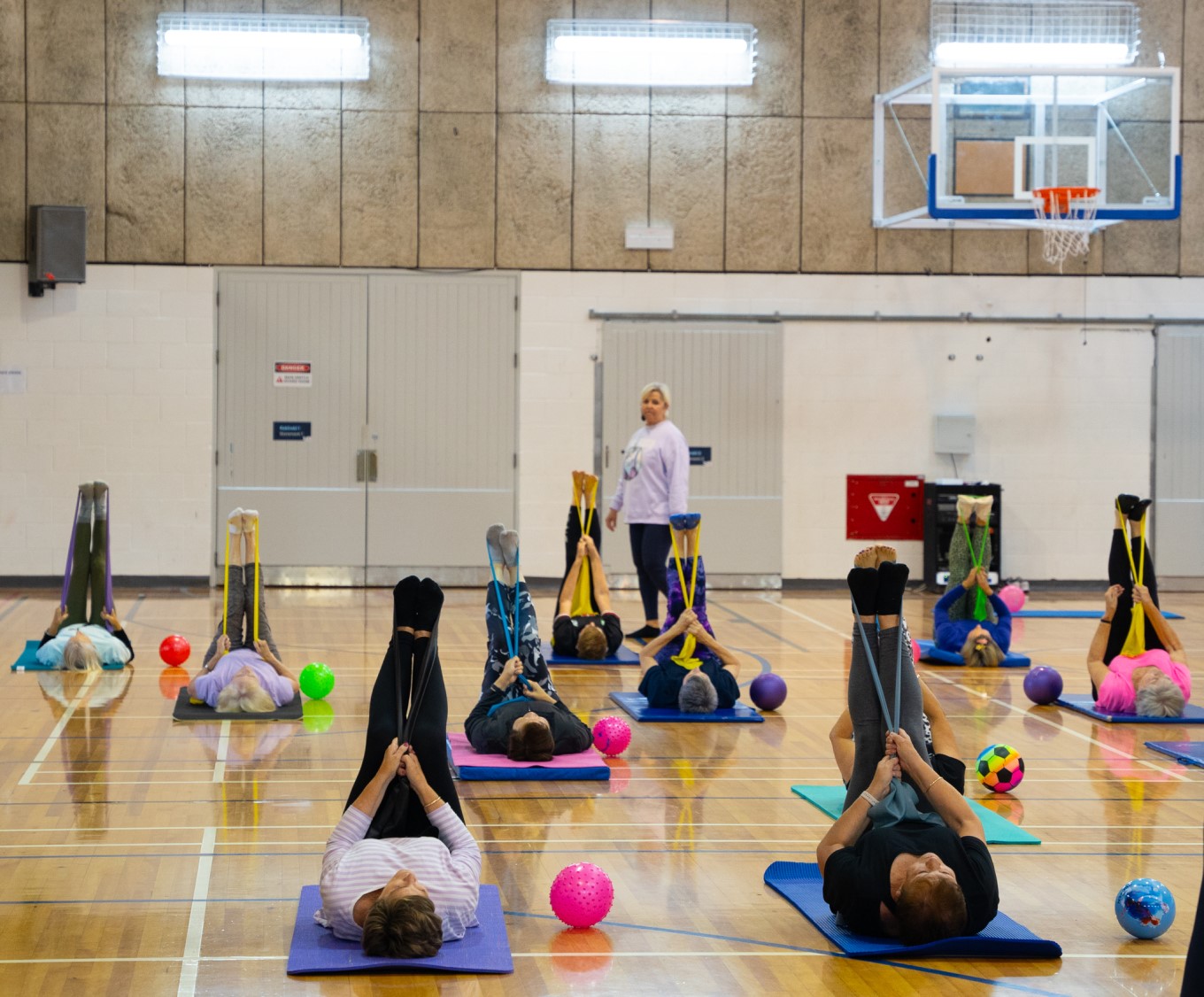
A FlexiFIT group class is a fun way to stay limber.
Take your workout to new lengths by swimming in one of Auckland Council’s public pools. Swimming is a full-body workout that is also low impact due to the buoyancy of the water. There are pools across the region, and in summer there are also locations such as Parnell Baths and Point Erin Pool – ideal for beating the heat.

The outdoor swimming lanes at Point Erin Pool are great way to cool off in summer while getting a dose of vitamin D.
Aqua fitness classes are a low-impact option well suited to those living with arthritis, struggling with obesity, recovering from an injury – or who simply like to cool off while exercising.
Hit the ground running in 2025 by pounding the pavement or the tracks. AKL Paths can help you find a path near you – the website helpfully states the amount of kilometres, walking steps and minutes of each track to help you meet your goals.
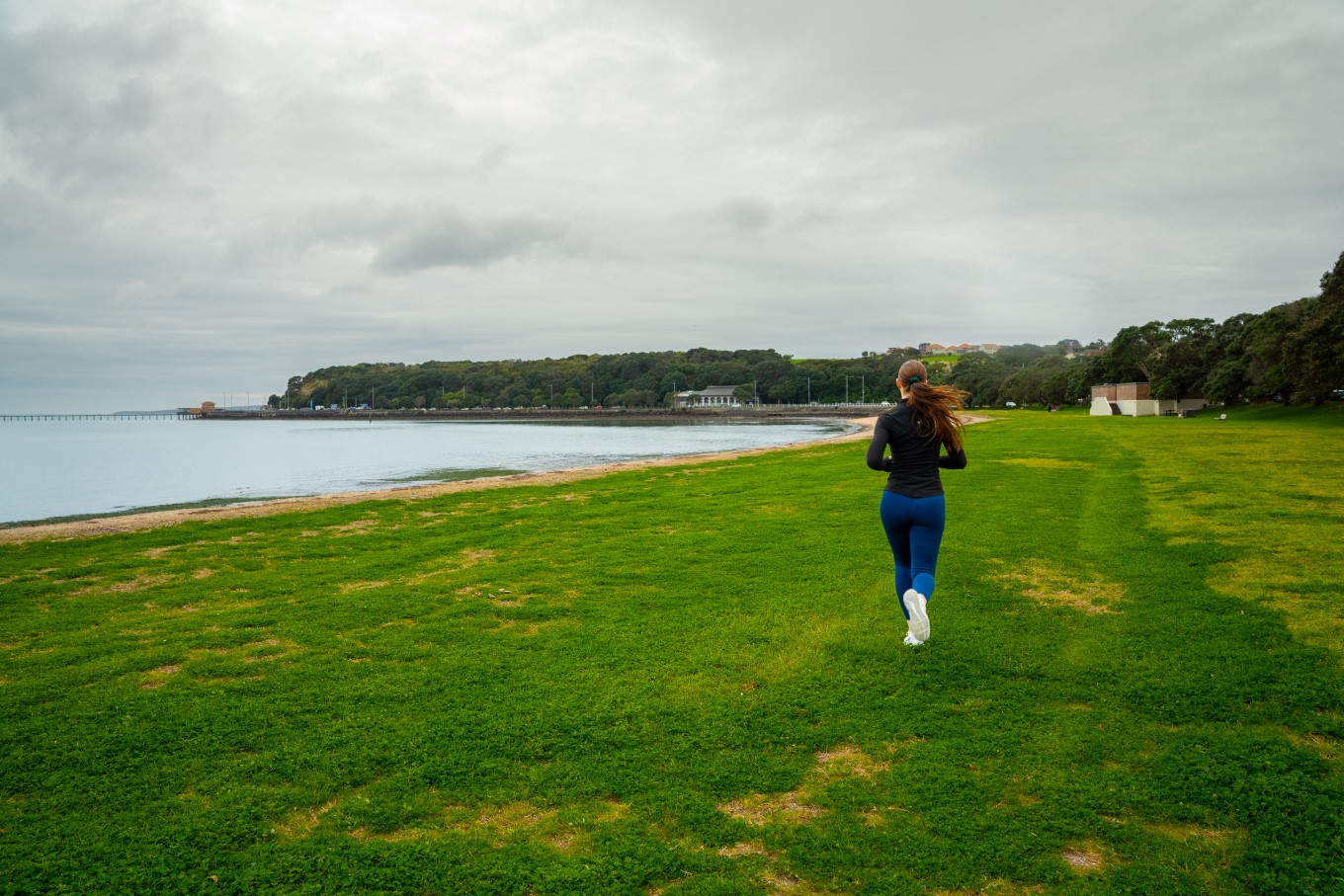
Okahu Bay Reserve is a great running spot.
For added motivation, why not set yourself the long-term goal of running in the Auckland Marathon in November? And to take your mind off your burning legs, try listening to an audiobook from Auckland Libraries while on the move.
With around 3200km of coastline, Auckland’s harbours, beaches and rivers are beautiful places to keep fit. Surfing or boogie boarding is not only fun but also an excellent workout – paddling exercises your shoulders, back, chest and arms, and balancing on the board works the core. The crumbly waves and beach breaks at Omaha and Ōrewa make them good options for beginner surfers. Piha is an internally renowned surfing beach, but due to its strong currents it’s best suited to advanced surfers.
There are lots of other ways to keep fit on the Auckland coast such as stand up paddleboarding at Takapuna Beach or kayaking at Ōrākei Basin (check the flushing schedule).
Before taking to the water always check the conditions at Safeswim and if there are lifeguards on the beach make sure to swim between the flags.

Ōrākei Basin is a great spot for kayaking. The flushing schedule shows when the basin will be tidal and the online schedule also shows when the basin is used for waterskiing.
Fitness
Is hot yoga good for you? What to know about the benefits, potential risks and more
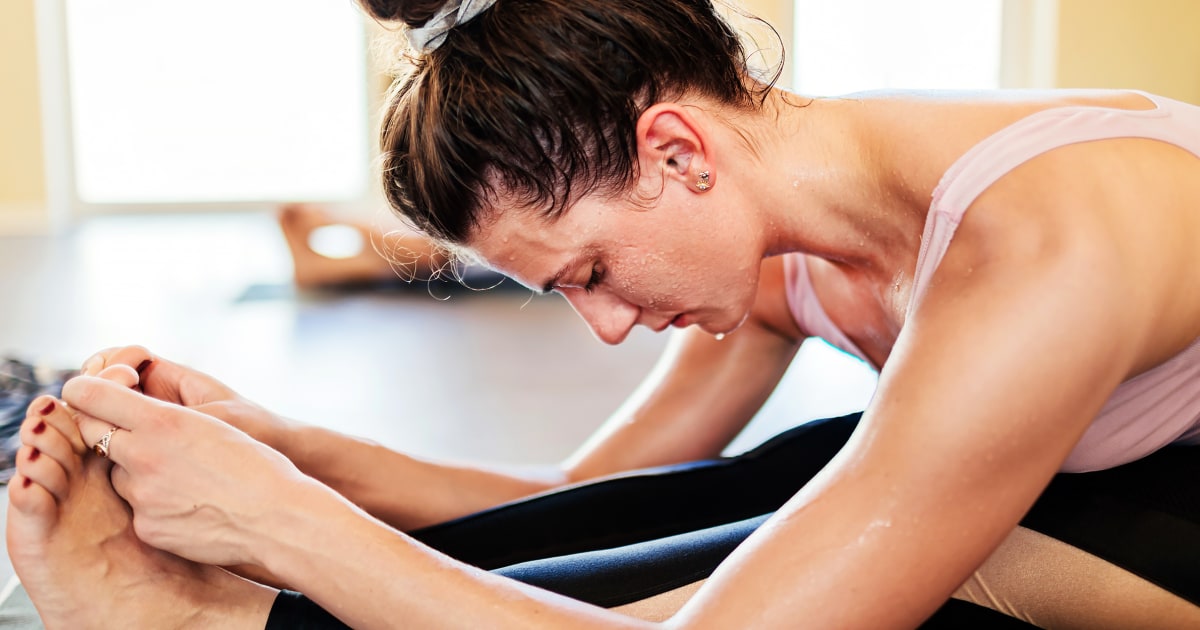
Yoga can be challenging to begin with, but doing it in a heated room can feel next-level intimidating.
Like most forms of exercise, hot yoga comes with benefits as well as risks to know about prior to your first class. The heated mind-body practice is beloved by some, while it’s a hard skip for others. But is it for you?
Read on to learn more about what is involved in hot yoga, any benefits and risks associated with the practice and a glimpse at what you could see in class.
What is hot yoga?
Hot yoga is just what it sounds like — yoga done in a heated room.
The practice was popularized by Bikram yoga, a hatha-style class done in a 105-degree room with 40% humidity, consisting of 26 postures and two breathwork sequences. Bikram, named after its controversial founder who was the subject of the 2019 Netflix documentary, began in the 1970s, and many other practices of hot yoga have since emerged.
The length, temperature and yoga style that make up a hot yoga class is largely dictated by the studio you’re practicing at.
At Modo Yoga LA, for example, the temperature is kept at 99-100 degrees and 40-60% humidity, a formula that its co-founder Alice Toyonaga describes to TODAY.com as accessible, sustainable and follows one of their pillars, “be healthy.”
Toyonaga says their studios offer hot yoga classes in traditional yoga styles, such as hatha, vinyasa and yin, but also hybrid series that incorporate other workouts, such as HIIT or Pilates, in a heated room.
“Just like with everything else, not all hot yoga is created equal,” Toyonaga explains. “And so, quite often, we’ll have people who’ve been like, ‘Oh, I tried this, and that wasn’t for me.’ And that’s absolutely fair, and it doesn’t mean that one type is right or wrong.”
Hot yoga temperature
In Bikram hot yoga, poses are performed in a 105-degree room with 40% humidity. For other hot yoga classes, the studios determine the temperature. While Cleveland Clinic reports that the room for hot yoga is typically heated between 90 and 105 degrees, the temperature can go lower or higher than that range.
Is hot yoga good for you?
The physical and mental benefits of doing yoga apply to its heated version. Common pros to the practice include building muscle, toning, increasing flexibility, dealing with the stresses of daily life and practicing mindfulness. But some of those benefits are amplified in elevated heat.
Improved flexibility
When exposed to higher temperatures, Toyonaga says muscles become more flexible and joints increase their range of motion.
“While there are definitely demographics of people who do yoga who are already quite flexible, what they need to work on is, let’s say, strength over mobility,” she continues. “We are working on a computer. We’re hunched over. We are behind the wheel of a car here in LA. So there’s just a lot. We’re just a static culture, so to speak.”
“And so, we do need any little assist to our range of motion to get a deeper stretch within poses,” she continues. “The heat is definitely something that helps to do that.”
Improved heart health
Another plus to doing hot yoga is that it’s more physically demanding and therefore makes the heart pump faster, which can improve cardiovascular health, as long as there are no preexisting conditions.
Reduced stress
Beyond the physical benefits, hot yoga can also help one’s mental state through the adversity faced inside of a heated room and the de-stressing that comes with it.
“It does play a big psychological role in that you are overcoming this challenge and adversity with your breath, and you’re doing that on your mat,” Toyonaga says. “It’s a controlled environment, but what an awesome lesson that we can take with us in line at Trader Joe’s.”
She added: “I feel like a lot of the times, with the heat and we’re trying to get through this class, we are in a way becoming more present than when we’re off of our mats because we are focused on this next breath, this next pose, this next sequence, and being that embodied and that present really helps us get out of our own way and (is) a really nice way to destress.”
Are there any risks or dangers to hot yoga?
When thinking about doing a hot yoga class for an extended period, you might be wondering if the heated practice comes with any health risks.
First, and most importantly, if you have any specific concerns or underlying preexisting conditions, always check with your doctor before taking a hot yoga class.
A common risk when it comes to practicing hot yoga is dehydration, due to the loss of water weight from sweating in high temperatures and humidity. This can lead to feeling faint or ill during class.
Toyonaga stresses the importance of having an ample amount of water before and after class, because if you start to feel unwell during the practice, you might already be dehydrated and “drinking during that yoga class is not going to make much of a difference.”
While heat helps muscle flexibility and loosens joints, Dr. Jordan D. Metzl, a sports medicine physician at Hospital for Special Surgery, says it’s important to avoid exaggerating your stretches at the risk of injury.
“The risk is you can overstretch a hamstring or a quad or a hip, and sometimes put yourself in a position where you’re getting a little more stretch out of that muscle than it’s used to being,” he tells TODAY.com.
“You can sometimes make an injury a little more pronounced than it would normally be because you get the position a little more exaggerated than you normally would be because you don’t feel it as much when you’re in that really hot environment,” he continues.
Metzl gives simple advice to prevent yourself from going too deep into stretches: Listen to your body.
“You just have to be smart about not looking at the person next to you and trying to emulate them,” he continues. “Just listen to your body … to make sure you’re not overdoing it, and just being mindful that you’re not feeling really faint or it’s too much for you, especially at the beginning.”
Natalia Perez-Segnini, a yoga teacher, functional and therapeutic breathwork coach, Tone House coach and mindset guide, encourages taking a rest or stepping outside the studio, if you start to feel unwell.
“Stop, lay down, get in child’s pose, Savasana, a restful position for you and find your breath again,” she tells TODAY.com. “And when you’re able to feel that steady flow within your inhales and your exhales, then ask yourself if you want to try it again.”

What should beginners know before going to class?
In addition to staying hydrated before and after class, and understanding the potential risks of the practice, people who are new to hot yoga should generally take their first few classes slow and focus on adjusting to the temperature.
“The first three to five classes, you’re getting used to the heat. That’s what you’re doing,” Toyonaga says. “You need to rest as much as you need to rest in that room, so that we’re getting used to the heat. So if you lie there for the whole hour, just pretend you’re on the beach in Mexico. You’re still doing it.’”
Perez-Segnini emphasizes that for all yogis, but especially beginners, it’s important to pay attention to how they feel throughout the course of the practice.
“This practice, hot yoga, regular yoga in general, is less about the shapes that you’re making with your body, and more about what you feel in your body,” she explains.
Perez-Segnini says that when she first started taking up hot yoga, she wishes someone told her that you don’t have to stick to just one intention, but rather figure it out as you go.
“In class, in the middle of a posture, halfway through, after, you’re allowed to change your mind about the why,” she says. “You’re allowed to change your mind about what you’re doing, and if that means coming out of a pose because you don’t feel great, or realizing that you’re taking it too far … there’s always time to change our minds, no matter where we’re at in life, no matter where in class we are.”
What to wear to hot yoga
What do you wear while exercising in an over-90-degree room for an extended period of time? When in doubt, go with something that you feel comfortable in — and avoid cotton.
“What we will see in the hot room will be more technical fabrics, like things that you would wear to the gym, as opposed to cotton,” Toyonaga says. “A lot of our favorite brands have sweat-wicking clothing, whether it’s tights or shorts, sports bra, a tank top, T-shirt, whatever it is.”
Perez-Segnini says that while it may seem “counterintuitive,” she wears a sports bra paired with pants, which absorb her sweat and gives her more traction.
“If there are any arm balances in class, (there’s) no shot I’m able to pop up into crow with shorts on because I’m sweating so hard, and then that’s dangerous, because you’re slipping off of your own skin,” she explains. “There’s more traction, you have more grip available, depending on the posture that you’re in, when you have skin to fabric contact.”
However, Perez-Segnini says that everyone has different preferences, and that finding what works best for you clothing-wise is part of the process.
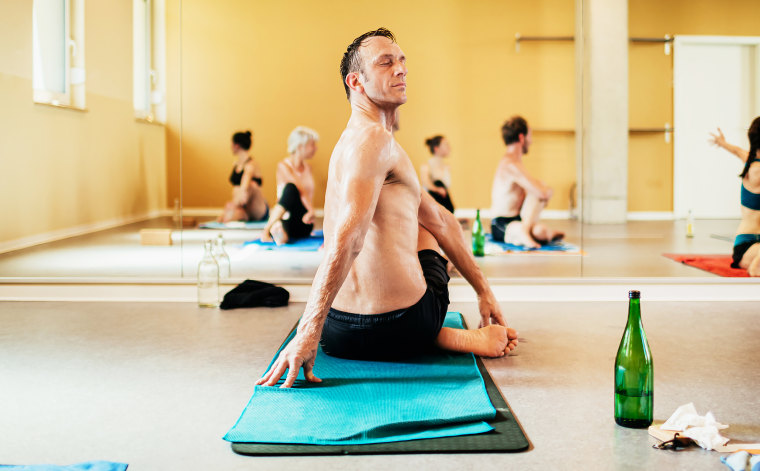
Poses in hot yoga classes
Just like in any yoga class, the postures you’re asked to do will vary by location and instructor, and there aren’t any poses specific to hot yoga itself. However, here are some common postures to get you in the right mindset for what’s to come.
Fitness
Can a Tampon Fall Out During Exercise? | Well+Good

If you’re a person with a period and a penchant for exercise, odds are you’ve wondered: Are there any risks to working out with a tampon?
The short answer is that it is safe to exercise with a tampon in, and it shouldn’t fall out—as long as you insert the tampon correctly and switch it out often enough, that is. Otherwise, there are rare instances when the menstrual product could shoot out of your coochie faster than soda out of a Coca-Cola bottle during a baking soda experiment.
We spoke to a team of obstetrics-gynecology and pelvic floor specialists to answer your questions about wearing a tampon while you exercise. Ahead, what every person with a monthly gym membership and menstrual cycle needs to know.
Experts In This Article
- Aldene Zeno, MD, FACOG, double board-certified OB/GYN and urogynecologist in Los Angeles, California
- Heather Jeffcoat, DPT, doctor of physical therapy, owner of Femina Physical Therapy, and author of Sex Without Pain
- Shannon Chavez, PsyD, CST, licensed psychologist and certified sex therapist
- Sherry A. Ross, board-certified obstetrics-gynecologist and co-founder of Oneself & the Women’s Health & Wellness School on the Mproov app
First up: Is it safe to wear a tampon while you exercise?
This past summer, fear-mongering headlines about “toxins” in tampons were as rampant as lime green manicures (case and point), leading many people with periods to wonder if their go-to menstrual product is safe to wear in or out of the gym. Despite clickbait to the contrary, “tampons are safe,” says double board-certified obstetrics-gynecologist and urogynecologist Aldene Zeno MD, FACOG, owner of and surgeon at Essence Health and Urogynecology in Los Angeles.
An August 2024 study1 published in Environment International reported trace amounts of arsenic, lead, mercury, nickel, copper, and iron in tampons. However, “concerns about the amount of toxins found were exaggerated by the media,” says licensed psychologist and AASECT-certified sex therapist Shannon Chavez, PsyD, CST.
The levels of these metals measured in the 24 tested tampons were minuscule. “The amount of trace metals found in the tampons is a fraction of what is permitted by the Environmental Protection Agency,” says Dr. Zeno. Not to mention, the levels aren’t higher than the trace amounts of metals found in our tap water, bottled water, green and black tea, most food, and even our air, she says.
“This study also didn’t test for the ability of these metals to leach into the body’s circulation, and according to the study authors, no studies have assessed risk of vaginal exposure to metals,” says Dr. Zeno. Meaning, there’s no proof that the chemicals actually make their way into your system through your vagina.
All that said, “yes, it is safe to exercise while wearing a tampon,” says Dr. Chavez. To date, there’s no scientific evidence suggesting any risk from wearing one during exercise, she says. Beyond just being safe, when worn correctly, tampons can help an individual feel secure, low-stress, and supported while exercising, says Dr. Chavez. This is important because “the benefits of exercise while menstruating are well-documented2,” says Dr. Zeno.
Fears of your tampon safety or security shouldn’t keep you from the gym.
So… can a tampon fall out during exercise?
No, it shouldn’t. “Tampons are designed to stay in place when your body moves, including during intense movement and exercise,” says Dr. Chavez. So, whether you’re lifting weights or doing cardio, working out on land or in water, at low or high intensities, your tampon should stay put, she says.
That said, there are a few rare instances when a tampon could fall out during exercise. Here are four reasons a tampon could fall out while you exercise.
1. The tampon isn’t inserted correctly
The most common reason for a tampon to fall out during exercise is that it wasn’t inserted correctly, according to Heather Jeffcoat, DPT, a pelvic floor therapist who specializes in incontinence and dyspareunia and the founder of Fusion Wellness & Physical Therapy in Los Angeles.
When inserted properly, a tampon will rest in the upper third portion of the vaginal cavity so that the top end of the product is near the cervix, says Dr. Zeno. “The vagina is shaped like an upside-down hockey stick, so this top portion of the vaginal canal is actually at a 45-degree angle to the floor when in a standing position, which helps keep it in place,” she explains. With that, “not inserting the tampon applicator deep enough into the vaginal canal before using the plunger to push it inside of your body could lead the tampon to fall out during exercise,” says Dr. Jeffcoat.
The good news: When a tampon is placed too low, you’ll be able to feel it, as the lower third is much more sensitive, says Dr. Zeno.“When it’s in the right place, you can’t feel it at all.”
2. The tampon is too saturated
Typically, tampons enlarge when they absorb fluid, which actually helps them stay in place, according to Dr. Zeno. However, if they become overly saturated, they can shift or fall out, she says.
To be clear, that doesn’t mean that you need to forgo exercise altogether if your flow is heavier than Ilona Maher’s deadlift. But “you may not be able to participate in an extended duration of exercise without stopping to replace your tampon due to saturation,” says Dr. Jeffcoat.
If stopping to replace and dispose of your tampon mid-workout isn’t feasible for you—for instance, because you’re an endurance event athlete going for gold—you might consider a menstrual cup or period panties, which can hold 3 to 12 times more than a regular tampon, respectively.
3. You have an underlying pelvic floor issue
The pelvic floor muscles are a complex network of muscles at the base of the pelvis that support bladder, uterus, vagina, and bowel (pelvic organs) placement and function. When these muscles are functioning optimally, they can contract and relax much like any other muscle in the body. But when there is an underlying issue, tampon placement, location, and security can all be affected.
Having overactive pelvic floor muscles—which essentially means having pelvic floor muscles that are “locked” into a contracted position—can make inserting a tampon difficult, says Dr. Jeffcoat. Caused by things like chronic stress, pelvic floor injury, or trauma (e.g., following childbirth or a car accident), habitually poor posture, or another pain-causing condition (e.g., endometriosis), having overactive muscles can lead individuals to place the tampon in the front-half of the vagina, which can lead to expulsion, she explains.
Pelvic floor muscle weakness can also lead tampons to fall out, according to Dr. Chavez. Usually, when this is the underlying cause, an individual will experience additional symptoms such as leaking urine, difficulty controlling the bladder, or a feeling of heaviness in the pelvis, says Dr. Chavez.
In both cases, working with a pelvic floor therapist can help. Likely, they will suggest a series of at-home pelvic floor exercises and diaphragmatic breathing, which can support muscle tone and improve comfort with using a tampon during exercise, says Dr. Chavez.
4. You’re bearing down while you lift
From better balance to boosted bone health, greater confidence to improved cardiovascular function, there’s no doubt that strength training offers tons of health benefits. Unfortunately, lifting with improper form can short you of those perks—and, yes, in certain instances, even cause your tampon to fall out.
Whether you’re bleeding or not, one of the riskiest things to do while lifting heavy weights is to bear down, or forcefully contract your abdominal, diaphragm, and pelvic floor muscles while holding your breath. This puts undue pressure on your back and pelvic floor muscles and incidentally cause your tampon to shoot out, says Dr. Zeno. (FYI: The pressure caused by bearing down can even lead to hemorrhoids and anal fissures).
Broadly speaking, rather than bearing down while you lift, experts suggest bracing your core. This allows you to engage all of those muscles and protect your spine without compromising your back, pelvic floor, or tampon position. Because bracing your midline while you lift requires complex coordinated muscle movements, Dr. Zeno recommends working with a fitness professional to learn how to lift correctly. “I highly recommend working with pelvic physiotherapists if you’re experiencing tampons falling out while you lift,” she says.
“I highly recommend working with pelvic physiotherapists if you’reexperiencing tampons falling out while you lift.” —Aldene Zeno, MD, FACOG
Do I ever need to avoid exercising while wearing a tampon?
Fears of your tampon safety or security shouldn’t keep you from the gym. However, there are times when your menstrual symptoms can (or should!) sideline you from your workout, according to says board-certified obstetrics-gynecologist Sherry A. Ross, MD, FACOG, co-founder of Oneself & the Women’s Health & Wellness School on the Mproov app and author of She-ology and The She-quel.
While exercising on your period can usually help symptoms, if you’re experiencing breast tenderness, headaches, painful cramps, or your flow is heavy and you’re passing clots, it’s important to listen to your body, she says. Meanwhile, it can be downright dangerous if your period is causing you to feel weak, tired, nauseous, or dizzy, as exercising safely requires energy, balance, and focus, she says.
The takeaway
At the end of the day, there is no reason to avoid exercising while wearing a tampon as doing so is safe, and the risk of expulsion is quite low. Just be sure to insert the tampon properly and change it regularly. If you’re struggling with tampon ejection, consult a pelvic floor therapist who can help suss out any underlying dysfunction, as well as suggest pelvic floor exercises and stretches, and other lifestyle interventions that can help you.
Well+Good articles reference scientific, reliable, recent, robust studies to back up the information we share. You can trust us along your wellness journey.
-
Shearston JA, Upson K, Gordon M, Do V, Balac O, Nguyen K, Yan B, Kioumourtzoglou MA, Schilling K. Tampons as a source of exposure to metal(loid)s. Environ Int. 2024 Aug;190:108849. doi: 10.1016/j.envint.2024.108849. Epub 2024 Jun 22. PMID: 38963987. -
Huang WC, Chiu PC, Ho CH. The Sprint-Interval Exercise Using a Spinning Bike Improves Physical Fitness and Ameliorates Primary Dysmenorrhea Symptoms Through Hormone and Inflammation Modulations: A Randomized Controlled Trial. J Sports Sci Med. 2022 Dec 1;21(4):595-607. doi: 10.52082/jssm.2022.595. PMID: 36523895; PMCID: PMC9741723.
Our editors independently select these products. Making a purchase through our links may earn Well+Good a commission.
-

 Business1 week ago
Business1 week agoOpenAI's controversial Sora is finally launching today. Will it truly disrupt Hollywood?
-

 Politics6 days ago
Politics6 days agoCanadian premier threatens to cut off energy imports to US if Trump imposes tariff on country
-
/cdn.vox-cdn.com/uploads/chorus_asset/file/25782636/247422_ChatGPT_anniversary_CVirginia.jpg)
/cdn.vox-cdn.com/uploads/chorus_asset/file/25782636/247422_ChatGPT_anniversary_CVirginia.jpg) Technology7 days ago
Technology7 days agoInside the launch — and future — of ChatGPT
-
/cdn.vox-cdn.com/uploads/chorus_asset/file/25789444/1258459915.jpg)
/cdn.vox-cdn.com/uploads/chorus_asset/file/25789444/1258459915.jpg) Technology5 days ago
Technology5 days agoOpenAI cofounder Ilya Sutskever says the way AI is built is about to change
-

 Politics5 days ago
Politics5 days agoU.S. Supreme Court will decide if oil industry may sue to block California's zero-emissions goal
-
/cdn.vox-cdn.com/uploads/chorus_asset/file/25546252/STK169_Mark_Zuckerburg_CVIRGINIA_D.jpg)
/cdn.vox-cdn.com/uploads/chorus_asset/file/25546252/STK169_Mark_Zuckerburg_CVIRGINIA_D.jpg) Technology5 days ago
Technology5 days agoMeta asks the US government to block OpenAI’s switch to a for-profit
-

 Politics7 days ago
Politics7 days agoConservative group debuts major ad buy in key senators' states as 'soft appeal' for Hegseth, Gabbard, Patel
-

 Business3 days ago
Business3 days agoFreddie Freeman's World Series walk-off grand slam baseball sells at auction for $1.56 million
